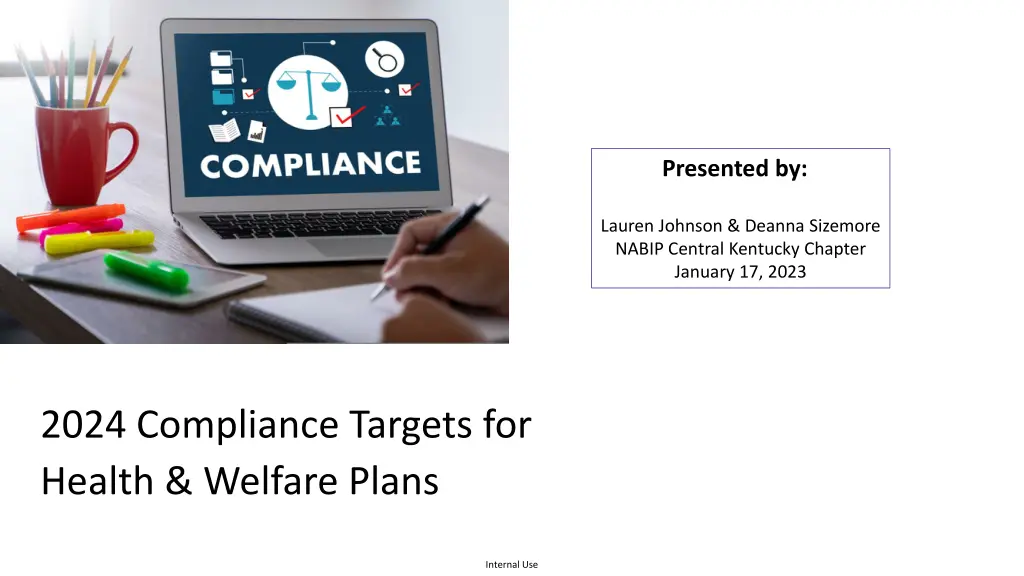
Understanding ERISA Compliance for Health & Welfare Plans
Explore the importance of ERISA compliance for health and welfare plans, including the key requirements, consequences of non-compliance, and common issues to address. Learn about the significant role of audits, fiduciary responsibilities, group health plan requirements, and the impact of regulations like the Affordable Care Act and the Consolidated Appropriations Act. Ensure proper plan documentation and stay updated on regulatory changes to avoid penalties and legal actions.
Download Presentation

Please find below an Image/Link to download the presentation.
The content on the website is provided AS IS for your information and personal use only. It may not be sold, licensed, or shared on other websites without obtaining consent from the author. If you encounter any issues during the download, it is possible that the publisher has removed the file from their server.
You are allowed to download the files provided on this website for personal or commercial use, subject to the condition that they are used lawfully. All files are the property of their respective owners.
The content on the website is provided AS IS for your information and personal use only. It may not be sold, licensed, or shared on other websites without obtaining consent from the author.
E N D
Presentation Transcript
Presented by: Lauren Johnson & Deanna Sizemore NABIP Central Kentucky Chapter January 17, 2023 Lauren Johnson President/Owner 2024 Compliance Targets for Health & Welfare Plans Internal Use
Why is Compliance Important? DOL has broad authority to audit compliance with ERISA Audits performed by the Employee Benefit Security Administration (EBSA) Focus is on ERISA compliance: Fiduciary obligations Reporting and disclosure Group health plan requirements Compliance with the Affordable Care Act (ACA) Compliance with the Consolidated Appropriations Act (CAA) of 2021 In 2022, EBSA saw a significant decrease in enforcement actions for the second consecutive year. EBSA Enforcement Actions 4E-09 Billions EBSA s recent pause in enforcement (EBSA Notice 2020-01) expires 60 days after the announcement of the end of the COVID-19 National Emergency (5/11/2023). 3E-09 2E-09 DOL s enforcement activity is expected to return to more typical levels due to the expiration of the NE. 1E-09 0 Increase in requirements under the Consolidated Appropriations Act (CAA) 2020 2021 2022 Internal Use
Why is Compliance Important? Audits are stressful and time consuming Disruption of day-to-day operations ERISA violations can be costly Penalties Corrective action Civil litigation and criminal prosecution Recovered in 2022 Enforcement Actions Voluntary Correction Program Abandoned Plan Program Informal Complaints $931 million $8 million $84 million $422 million Internal Use
ERISA Requirements Most group health plans sponsored by private sector employers ARE subject to ERISA. Subject to ERISA Exempt from ERISA Governments Churches Corporations Partnerships Sole Proprietorships Nonprofit organizations Internal Use
ERISA Requirements Plan Reporting & Disclosure Fiduciary Responsibility Document Group Health Plan Requirements ACA COBRA Internal Use
Plan Document ERISA requires every employee benefit plan to be established and maintained pursuant to a written plan document The plan document must be provided to a participant or beneficiary no later than 30 days after a written request Common Compliance Issues Relying on Certificate of Coverage as the plan document for fully insured plans Undocumented arrangements Flex Plans, HRAs and EAPs Poor documentation of benefits for self- funded plans Plan documents not properly amended for applicable law or benefit changes Tip: Consider a wrap document to supplement insurance documents and provide missing ERISA provisions. Internal Use
Summary Plan Description (SPD) & Summary of Material Modifications (SMM) Purpose is to communicate plan benefits, changes, rights and obligations to plan participants and beneficiaries Must be provided to plan participants and beneficiaries within 90 days of the effective date of coverage Must be re-distributed every 5 years if there have been any changes, 10 years if there have been no changes SMM or updated SPD must be provided to plan participants and beneficiaries no later than 210 days after the end of the plan year in which the change is adopted, if no material reduction in benefits or 60 days after the effective date of the change if there is a material reduction in benefits Best practice to distribute SPD with annual enrollment materials Common Compliance Issues Does not include required provisions (WHCRA, claims procedures, ERISA rights, etc.) Benefit booklets provided by health insurance carriers are not SPDs SPD does not properly reflect eligibility requirements Failing to distribute a SPD for each benefit plan Failing to distribute timely Internal Use
Participant Disclosures Notices Required to be Distributed Medicare Creditable Coverage Women s Health & Cancer Rights Act (WHCRA) Newborns & Mothers Health Protection Act (NMHPA) Premium Assistance under Medicaid & the Children s Health Insurance Program (CHIPRA) HIPAA Notice of Privacy Practices HIPAA Special Enrollment Rights Notice of Grandfathered Status (if applicable) Patient Protection Notice (if applicable) COBRA Notices Wellness Notice of Reasonable Alternative(s) ADA Wellness Notice (if applicable) Marketplace Exchange Notice COBRA compliance documents Surprise Billing Rights Notice ICHRA Notice QSEHRA Notice Internal Use
Form 5500 Must be filed by the end of the 7th month following the end of the plan year (July 31 for calendar year plans) 2 month extension is available if Form 5558 is timely filed Required for all retirement plans Required for unfunded welfare benefit plans covering more than 100 participants as of the first day of the plan year Required for welfare benefit plan regardless of size if funded Common Compliance Issues Filing a consolidated Form 5500 without a wrap document in place Failing to identify which benefits are subject to the filing requirement No blanket exemption for non-profit organizations Don t forget health FSAs, HRAs and certain EAPs Internal Use
Summary Annual Report (SAR) Summary of the information submitted on the annual Form 5500 Prescribed format Must be provided by the end of the ninth month following the end of the plan year (September 30 for calendar year plans) Extension of 2 months available if Form 5558 is timely filed Common Compliance Issues Common misconception SAR is not required for group health plans If fully-insured or plan is funded, SAR is required Internal Use
HIPAA Appointment of HIPAA Privacy & Security Officers Increased penalty provisions under HITECH Limit plan s uses and disclosures of protected health information (PHI) Breach/encryption protocols Minimum necessary use and disclosure Access controls Business Associate Agreements Risk assessment Annual HIPAA training for employees with access to PHI Privacy and Security Policies and Procedures Common Compliance Issues Hands-on fully-insured plan without proper HIPAA Privacy and Security Policies and Procedures Lack of required ongoing HIPAA training for employees with access to PHI Failing to complete ongoing risk assessments Internal Use
Affordable Care Act (ACA) DOL uses audit authority to enforce compliance with the ACA Grandfathered Plans Non-Grandfathered Plans Records supporting grandfathered status Participant notice regarding grandfathered status Coverage of preventive services PPA Notice Claims and appeals procedures All Plans Enrollment opportunities for children up to age 26 Coverage rescission rules Lifetime and annual limits Summary of Benefits & Coverage (SBC) Marketplace Notice W-2 reporting Excessive waiting periods Eligibility requirements Cost-sharing limits on essential health benefits (out-of-pocket maximum) Form 1094/1095 reporting PCORI Fees Common Compliance Issues Failing to track hours for part- time and variable hourly employees Failing to count part-time and seasonal employees Not issuing a Form 1095-C to all full-time employees Failing to document offers of coverage Internal Use
Summary of Benefits & Coverage (SBC) Prescribed format Required by the ACA Short summary of benefits and coverage under the plan Must be provided at enrollment, re-enrollment and upon request Employer must provide 60 days advance notice of any material modifications of plan terms or coverage not reflected in the most recent SBC. Common Compliance Issues Failing to provide updated SBC if benefits change mid-year Failing to distribute timely Information in SBC does not match SPD Internal Use
Affordable Care Act (ACA) Annual ACA Reporting Fully Insured < 50 FTEs Fully Insured > 50 FTEs Self-Funded < 50 FTEs Self-Funded > 50 FTEs Forms to Employees 1095-B 1095-B/1095 C(Parts I and II Only) 1095-B 1095-C (Parts, I, II and III) Issued by Insurer Insurer/Plan Sponsor Plan Sponsor Plan Sponsor Forms to IRS 1094-B and copies of 1095- B 1094-B and copies of 1095- B 1094-B and copies of 1095- B 1094-C with copies of 1095-C 1095-C and copies of 1095- C Filed by Insurer Insurer/Plan Sponsor Plan Sponsor Plan Sponsor Note: Effective with the 2023 reporting due in 2024, electronic filing is mandatory if employer is filing 10 or more returns in aggregate (includes Forms W-2s, 1099s and 1095s. Internal Use
Consolidated Appropriations Act (CAA) of 2021 Transparency in Coverage (TICRA) Consolidated Appropriations Act (CAA) Hospital Price Transparency 1/1/2022 1/1/2021 1/1/2021 1/1/2023 1/1/2024 Putting the F in Fiduciary Lack of clarity before CAA for the role of Plan Sponsor as the Fiduciary under ERISA/PHSA Contracts that restrict Plan Sponsors from full access to their data Lack of transparency in pricing and benefit plan administration Accountability for services provided Need for more aggressive enforcement of the federal Mental Health Parity and Addiction Equity Act (MHPAEA) Internal Use
Consolidated Appropriations Act (CAA) of 2021 Employer Fiduciary Responsibilities Across 4 Key Areas: Removes gag clauses from service provider contracts on price and quality information Establishes reporting requirements for prescription drugs and other medical spending Requires the disclosure of direct and indirect compensation from all service providers Requires annual Non-Quantitative Treatment Limitations (NQTL) analysis to demonstrate mental health parity Internal Use
Gag Clause Attestation Contracts with service providers cannot restrict (directly or indirectly) the Plan Sponsor s access to provider-specific cost or quality of care information necessary to meet their fiduciary duties: Plan Sponsors are required to attest annually starting 12/31/2023 Operate the plan solely in the best interest of participants and beneficiaries Verify that claims are properly processed and paid Identify waste and fraud through comparative analytics Plan Sponsors should ensure they have documented their due diligence and can attest truthfully Verify that fees associated with the plan are reasonable Provide participants and beneficiaries with access to information to make informed, cost-effective healthcare decisions Internal Use
Compensation Disclosure Requirement Must be provided to fiduciaries annually Service provider reasonably expects to receive $1,000 or more in direct or indirect compensation Requires disclosure of service provider s fiduciary status To assist Plan Sponsor in fulfilling their fiduciary duty to ensure fees are reasonable Development or implementation of plan design Recordkeeping Pharmacy benefit management Medical management Benefits administration Wellness services Transparency tools and vendors Disease management Compliance services EAPs Third-party administration Other services listed in the statute Internal Use
Prescription Drug Reporting (RxDC) Requires Plan Sponsors to report certain prescription (and health care) spending to HHS, DOL and Treasury by June 1st annually: Top 50 most frequently dispensed brand drugs Annual amount spent by the top 50 most costly drugs Amount spent for the top 50 most costly drugs in the prior year Total health care spending for the year Premiums and rebates Annual reporting requirement allows Plan Sponsors to demonstrate their fiduciary duty by obtaining information necessary to evaluate the economic interest of participants and beneficiaries. Employers should document requests for the RxDC plan-level information. The filing of the reports can be delegated to a third-party. However, the Plan Sponsor has the legal obligation to ensure timely, and complete filing. Internal Use
MHPAEA Non-Quantitative Treatment Limitations (NQTL) Required as of 2/10/2021 NQTLs are limits on the scope or duration of treatment that are not expressed numerically (such as medical management standards, formulary design, step therapy protocols and methods for determining usual, customary and reasonable charges) NQTL must be performed annually and is extremely complex The law requires plans to make their NQTL comparative analysis available upon request by any government agency (CMS, HHS, DOL, state authorities) The CAA requires plan sponsors to analyze non- quantitative treatment limitations on mental health/substance abuse disorder (MH/SUD) benefits to show parity with medical and surgical care (Med/Surg): *Does not apply to small self-funded plans of less than 50 employees Fully-insured plans who rely on the insurance carrier to complete the analysis should verify compliance and retain a copy on file in case of an audit. Self-funded plans will need to perform analysis using the DOL s MHPAEA Self-Compliance Tool or contract with a third-party vendor. Internal Use
MHPAEA Non-Quantitative Treatment Limitations (NQTL) The Departments of Labor, Health and Human Services and 2022 Report to Congress NONE of the comparative analyses initially reviewed to date have been sufficient (156 letters were issued) Deficiencies identified: Failed to identify the benefits, classifications or plan terms to which NQTL applies Failed to describe in sufficient detail how the NQTL was designed or how it is applied in practice to MH/SUD benefits and Med/Surg benefits Failed to analyze in sufficient detail the stringency with which factors, sources, and evidentiary standards are applied Failed to demonstrate parity compliance of NQTLs as written and in operation Internal Use
MHPAEA Non-Quantitative Treatment Limitations (NQTL) Potential Red Flags These types of plan provisions should be investigated to determine if they also apply to medical/surgical benefits and if they are being applied in a manner that complies with MHPEA. Preauthorization and pre-service notification requirements Fail-first protocols Probability of improvement Written treatment plan required Patient non-compliance Residential treatment limits Geographical limitations Licensure requirements Internal Use
MHPAEA Non-Quantitative Treatment Limitations (NQTL) July 2023, Agencies proposed new MHPEA regulations to bolster mental health parity rules and solidify NQTL comparative analysis Confirms eating disorders and autism spectrum disorder (ASD) are considered mental health conditions Adds additional requirements for plans that impose NQTLs to MH/SUD benefits Provides additional details on form and content of the NQTL comparative analysis N.R. v. Raytheon Co. Appellate court reinstates class action lawsuit for plan s denial of speech therapy for Autism Spectrum Disorder Internal Use
Miscellaneous Section 125 Cafeteria Plan Document if withholding employee premiums pre-tax through payroll Annual nondiscrimination testing (Safe Harbor for POP Plans) FMLA FMLA Poster General Notice Eligibility Notice Rights & Responsibilities Notice Annual CMS Reporting Online submission, due within 60 days of the beginning of the plan year Annual 105(h) Nondiscrimination Testing Applies to elf-funded plans including HRAs Internal Use
Minimize Risk Important to know how to prepare for (and potentially avoid) an audit Best time to analyze whether you are ready for an audit is before the DOL knows on your door Understand common audit triggers and the audit process Confirm compliance with applicable law Maintain documents to show compliance Internal Use
Questions? Lauren Johnson www.jbcpros.com laurenj@jbcpros.com (859) 277-4291 Internal Use






















